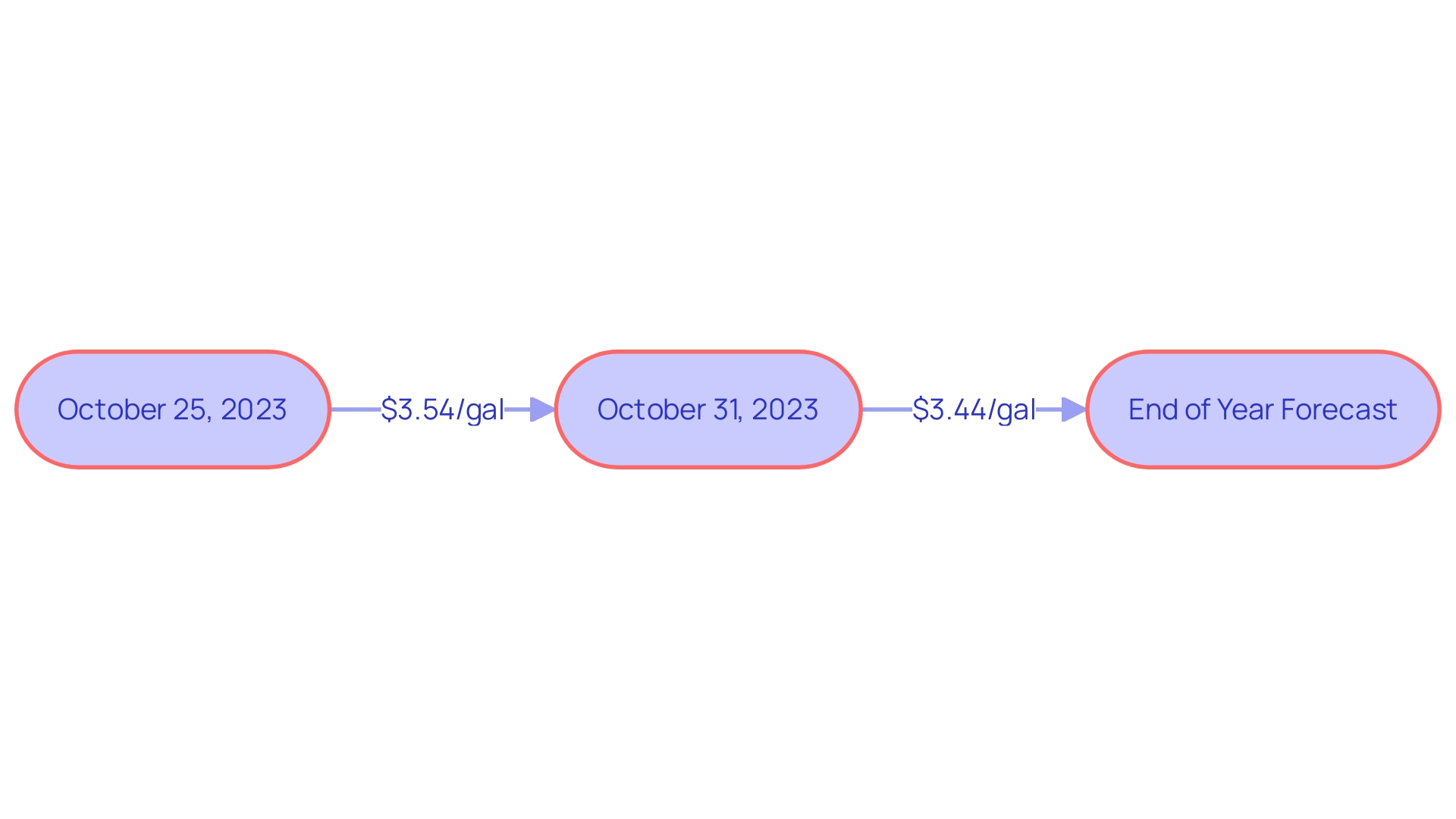Introduction
Gas prices are a critical aspect of economic stability and household budgeting, influenced by a multitude of factors. In Louisiana, MO, these factors combine to create day-to-day fluctuations in fuel costs. Understanding the nuances of gas prices within specific regions against the national backdrop is crucial for grasping the complexities of market dynamics.
This article examines the dynamics of gas prices in Louisiana, MO, including historical trends, comparative analysis with national prices, factors influencing gas prices, the impact of seasonal changes, and expert insights on gas price trends. By delving into these elements, we can better comprehend the oscillations in gas prices and their broader implications. So, let's explore the intricate mix of factors that shape the gas price landscape in Louisiana, MO.
Current Gas Prices in Louisiana, MO
The dynamics of gas costs are intricate and constantly shifting, influenced by a multitude of factors such as supply and demand, the cost of crude oil, and regional market conditions. In Louisiana, MO, like elsewhere, these elements combine to create day-to-day fluctuations in fuel costs. A key indicator of this volatility is the significant 27% increase in natural gas held in U.S. storage compared to the five-year average, underscoring the impact of production disruptions, weather patterns, and shifts in power generation fuel preferences. Additionally, although fuel costs are usually decreasing throughout the United States, with the national average falling to $3.243 per gallon, regional disparities endure. For example, Texas averages at $2.745, whereas California hits $4.815. These variations are shaped by local refinery access, geographical challenges, and state-specific taxes and policies. Moreover, it's important to mention that specific weekdays might present more favorable fuel costs; historically, Saturdays have been expensive, but in 2021, Thursdays saw the highest prices in 28 states. While we navigate these changes, it is crucial to stay informed about current gas costs to efficiently handle budgets and predict future trends.

Historical Trends in Louisiana Gas Prices
Gas costs are a crucial element of economic stability and growth, influenced by a multitude of factors ranging from geopolitical events to environmental policies. In Louisiana, MO, a retrospective analysis of gas costs reveals a complex interplay of market dynamics. Such an examination sheds light on the recurring patterns that have historically affected fuel costs in the region. For example, the influence of seasonal changes in demand, especially during periods of extreme temperatures, is apparent in the rise and fall of costs. Warmer summers increase electricity demand for cooling, subsequently driving up the demand for natural gas, which in turn can result in spikes in cost, especially when supply is limited. These trends are not only pivotal for consumers but also for stakeholders in the energy sector who rely on accurate predictions to strategize and manage resources efficiently. The historical data from a specific region in Missouri encapsulates these nuances, providing a valuable reference point for forecasting future trends and preparing for market shifts.
Comparative Analysis: Louisiana vs. National Gas Prices
Comprehending the intricacies of gas costs within particular areas in contrast to the national context is essential for understanding the complexities of market dynamics. MO, for instance, may display unique pricing patterns that are influenced by a multitude of elements, such as local demand, supply disruptions, or even tax policies. It's crucial to explore this comparative analysis to determine whether Louisiana's gas costs are simply a manifestation of national trends or if they are influenced by distinct, localized elements.
Recent data indicates that the national average for gasoline has undergone a substantial decline, falling 38 cents in the past month, with current costs averaging $3.44 per gallon. This decrease is attributed to a combination of elements, including seasonal changes resulting in reduced consumption and the transition to winter blend gasoline. Furthermore, enhancements in refinery operations in specific areas have relieved some of the cost burdens that were previously observed.
Considering the way these elements manifest on a local level in Louisiana, MO, within the context of these national trends. For instance, the strategic choices made by OPEC can have a ripple effect on the costs incurred at the pump. A recent reduction in production by the organization has contributed to the increase in fuel costs, a factor that regional gas costs cannot avoid. Additionally, the presence and variety of energy sources in nearby regions, like Wyoming's dependence on utility gas and electricity for heating, can also impact local fuel demand and thus affect costs.
Hence, it is crucial to take into account the wider economic and geopolitical context when examining the cost of fuel in MO, considering factors such as global oil reserves and production constraints, as well as local energy usage patterns. This comprehensive approach allows for a more informed understanding of whether the regional gas costs are behaving independently or are in lockstep with the national average.

Factors Influencing Gas Prices in Louisiana
'Gas costs are a crucial element of economic stability and household budgeting in locales such as Louisiana, MO.'. These costs are influenced by the interplay of various factors, including global crude oil prices, which act as a basis for determining local expenses, as well as more detailed elements such as refinery operations, transportation logistics, and the complex network of taxes and regulatory measures. An excellent instance of the subtle character of gas costs can be observed when investigating the influence of weather on natural gas, a crucial raw material for power generation. Extended periods of high temperatures can increase the demand for electricity, thus escalating the requirement for natural gas and potentially causing spot market costs to surge, particularly when supply is limited or storage levels are suboptimal.
Experts, like Mike O'Boyle and colleagues, have analyzed the energy sector inflation and suggest that recent increases in clean energy costs are likely temporary, suggesting a potential reprieve in the near future. However, the importance of strategic measures like improving supply chains and transmission planning cannot be overstated in mitigating these costs long-term.
Additionally, reports from the AAA emphasize that, as of late October 2023, the average national gas cost was $3.54 per gallon, with notable differences across states. Closeness to refineries is an important consideration; for example, states like Texas often experience lower prices due to their closer refinery access. This direct correlation underscores the importance of understanding the local and regional infrastructure's role in shaping fuel costs.
To sum up, the gas cost situation in MO is influenced by a complex combination of elements, ranging from worldwide economic patterns to regional infrastructure and environmental circumstances. By exploring these components, we can gain a deeper understanding of the fluctuations in gas costs and their wider consequences.
Impact of Seasonal Changes on Gas Prices
In Louisiana, MO, gas costs are influenced by an array of seasonal factors, with shifts in travel patterns during holidays and weather-related changes being particularly impactful. The summer and winter months bring about distinct challenges and trends in the fuel market. During peak travel periods such as summer vacations and winter holidays, there is a clear increase in fuel consumption as families begin road trips, which can lead to higher demand and, consequently, impact costs.
Nevertheless, it's not only the act of traveling that impacts the cost of gas. The cost of crude oil, which is the primary component in gasoline production, is the most significant driver. As oil costs change because of worldwide market powers, gas costs react appropriately. Especially during the winter months, there is often a decrease in natural gas costs, which can result in reduced heating bills for households that depend on this fuel source.
Moreover, the approach of winter can introduce volatility in energy markets, especially in the liquefied natural gas (LNG) trade. Energy consumption patterns become less predictable, necessitating advanced scenario planning for those in the industry to effectively manage the uncertainties of seasonal demand.
To provide a clearer understanding of these dynamics, entities such as the Federal Energy Regulatory Commission (FERC) regularly assess and report on market conditions, offering insights into emerging trends. Their findings help industry stakeholders navigate the complexities of the energy landscape throughout different seasons.
To sum up, although seasonal elements do have an impact on the fluctuations in the cost of gas, they are a component of a more extensive and intricate framework that encompasses oil prices, evaluations of the energy market, and the wider economic backdrop. By keeping abreast of these factors, consumers and industry professionals in Louisiana, MO can better anticipate changes and strategize accordingly.
Expert Insights on Gas Price Trends
The ever-changing landscape of gas costs is a crucial consideration for industry stakeholders. There has been a significant change as the average national gas cost has recently dropped by 38 cents, with forecasts suggesting a further reduction. Starting from October 31, 2023, numerous gas stations throughout the United States are providing fuel at the attractive rate of $2.99 per gallon. This reduction to the lowest national average since March 28 is attributed to a combination of seasonal adjustments, such as reduced consumption during colder months, and the switch to winter gasoline formulations. Furthermore, enhancements in refinery operations, especially in regions previously impacted by production difficulties, have also played a role in this decreasing pattern in costs. This analysis incorporates the latest data and perspectives from GasBuddy, a prominent fuel savings platform, to provide a comprehensive view of current and emerging gas price trends.

Conclusion
In conclusion, gas prices in Louisiana, MO are influenced by factors such as supply and demand, crude oil prices, regional market conditions, and seasonal changes. Understanding these complexities is crucial for effective budget management.
Historical trends reveal the impact of seasonal demand fluctuations, providing valuable insights for forecasting and market preparation.
Comparative analysis between local and national gas prices helps determine if regional prices reflect national trends or unique factors. Recent data shows a significant decrease in the national average due to reduced consumption and the transition to winter blend gasoline. Strategic decisions by organizations like OPEC and energy source availability also influence local prices.
Multiple factors, including global crude oil prices, refinery operations, logistics, taxes, and regulations, influence gas prices in Louisiana, MO. Weather conditions, like prolonged hot weather, can amplify natural gas demand and cause spot market prices to soar. Experts suggest that recent clean energy cost increases are likely temporary, emphasizing the need for long-term cost mitigation strategies.
Seasonal changes, such as shifts in travel patterns and weather fluctuations, impact gas prices. Major travel seasons and global oil market forces drive up demand and prices. The approach of winter introduces volatility in energy markets, requiring advanced scenario planning.
The dynamic gas price landscape is crucial for industry stakeholders. The national average has recently decreased due to seasonal adjustments and improved refinery operations. Staying informed on current trends is vital for anticipating changes and making informed decisions.
Understanding the factors shaping gas prices in Louisiana, MO allows for a comprehensive understanding of price oscillations and broader implications. By considering the economic and geopolitical landscape, consumers and industry professionals can navigate the complexities effectively.




